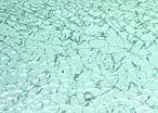 |

|
|
|
ARTICLES
Tempered glass breakage
 A frequent misperception about tempered glass regards its resistance to breakages. Many consider it "unbreakable" or "nearly unbreakable". Such is not the case. As with every other type of glass,
also tempered glass can break.
A frequent misperception about tempered glass regards its resistance to breakages. Many consider it "unbreakable" or "nearly unbreakable". Such is not the case. As with every other type of glass,
also tempered glass can break.Glass breaks when it is exposed to stresses that it cannot withstand. To increase its strength and heat resistance annealed glass can be subjected to a thermal treatment or chemical process. Tempered glass is obtained using this process, and its final form is four to five times as strong as annealed glass of the same type and thickness. When broken, it shatters into many small fragments, which prevent major injuries. Due to these characteristics tempered glass is used traditionally in applications requiring increased strength and reduced likelihood of injury in the event of breakage. Tempered glass should receive the same care as annealed glass. Unfortunately, the perception of “unbreakable” characteristics of tempered glass may mislead people to provide less care while handling it. Careless handling and improper installation sometimes produce damage, which leads to “spontaneous breakage” or “delayed breakage”. This means that occasionally a sheet will not shatter immediately at the time of damage, but perhaps weeks later. Inclusions in glass such as NiS can also trigger a delayed breakage effect. Nickel sulphide inclusion, also known as NiS, occurs during the manufacturing process for float glass. In a glass batch, nickel-rich contaminants such as stainless steel might be present, and then combine with sulphur to form nickel sulphide inclusions. To minimize the risk of NiS breakages, a heat soak test is performed. Although some spontaneous breakages occur due to the above-mentioned factors, much breakage is called "spontaneous" just because there is no easily visible cause. |